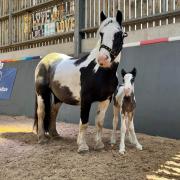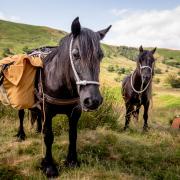An anniversary in Lakeland has given an art gallery a great excuse for showing off its treasures – and solving a riddle. Mike Glover reports
It was 50 years ago that Princess Margaret officially opened Abbot Hall art gallery in a lovely Georgian house overlooking the River Kent at the southern entrance to Kendal.
To mark the milestone the Lakeland Arts Trust, which runs the gallery, has planned a year of celebrations and special events, which will take their inspiration from the highlights and strengths of Abbot Hall’s permanent collection, spanning several centuries.
From April 27 to June 9, Abbot Hall at Fifty will show key pieces from the 4,000-strong collection with works by George Romney, JMW Turner, John Ruskin, Ben Nicholson, Sheila Fell, Kurt Schwitters, Stanley Spencer, David Hockney, Bridget Riley and many others.
It was the exhibition Turner and his Contemporaries which got the celebrations under way with a unique showing of the renowned but rarely seen Hickman Bacon Watercolour Collection. This runs until April 14.
But alongside the Turner show, there is another exhibition, featuring an artist who took his inspiration from the genius of watercolour, and whose tragic death is marked by another noted anniversary.
Edward A Wilson (1872-1912) was a physician, naturalist, explorer and artist who accompanied Captain Scott to Antarctica on both The Discovery (1901-4) and Terra Nova (1910-13) expeditions.
It is 100 years since Scott, Wilson, Henry Robertson (‘Birdie’) Bowers, Edgar Evans and Captain Lawrence Oates reached the South Pole, all dying on their return. Wilson was probably Scott’s closest comrade and he said of him: ‘I believe he really is the finest character I ever met.
’When Scott’s final camp was discovered Wilson was frozen in his sleeping bag and Scott’s left arm was extended across his friend.
The exhibition of all eight of Abbot Hall’s original Wilson Antarctic watercolours and drawings pays tribute to the seemingly contradictory roles of Wilson as creative artist and objective scientist. In addition there are three pen and ink drawings from his student days and a selection of his nature study lithographs.
Wilson sought to convey not just the topographical details of the unchartered terrain he encountered, but also the wonder, hardship and sublime impressions he experienced of the polar landscapes.
But how did Abbot Hall come to possess these works, as Wilson is a celebrated son of Cheltenham where his statue stands?It was only while collection manager Nick Rogers was preparing for the exhibition that he solved this mystery when he came across a letter, dated February 28, 1964, in the gallery archives.
It was from Rev. James Wilson, brother of the explorer artist, to a Mr F. C. Scott, who almost certainly was Francis C Scott, who owned the Provincial Insurance Company, which was based in Kendal.
The Scott family has a reputation for philanthropy, with a number of charitable trusts instrumental in the setting up of Abbot Hall Art Gallery, as well as the town’s Brewery Arts Centre and Brathay Trust at Windermere.
This letter offered the gallery a small collection of his brother’s paintings and drawings. ‘I always feel they ought to have a permanent home where many people could enjoy them,’ he writes.
‘Another reason for this idea is the fact that the Wilson family were originally scattered over the counties of Lancashire, Westmorland and the West Riding of Yorkshire. Some of the Pennine towns have the half wolf rampant as a crest, as we do.
‘Thomas Wilson (1665) lived in the West Riding and moved to Trawden near Colne and was a very active Quaker and visited Kendal, and there are Wilsons now in Kendal with our crest and motto.
’A further family link enters the story on March 22 with Dr Edward A Wilson’s great-nephew, and accomplished photographer, Christopher Wilson, giving a seminar on the polar artist’s expeditions and works, at Abbot Hall.
The print version of this article appeared in the March 2012 issue of Lancashire Life
We can deliver a copy direct to your door – order online here


























